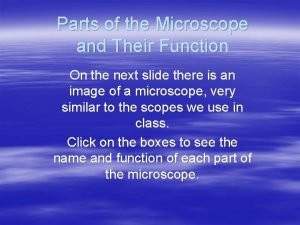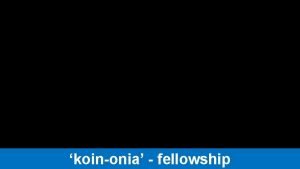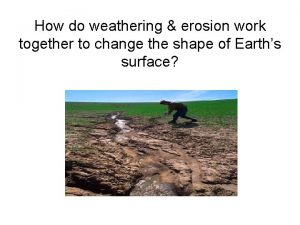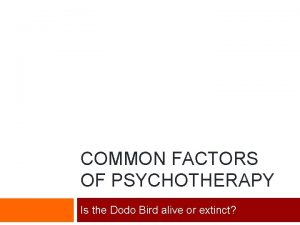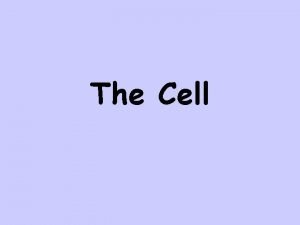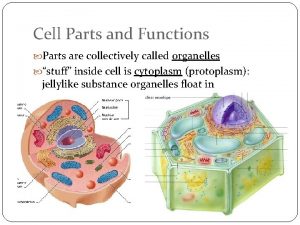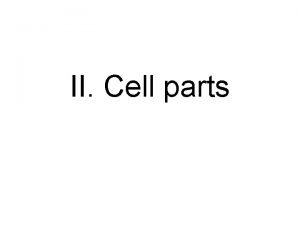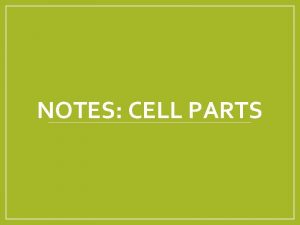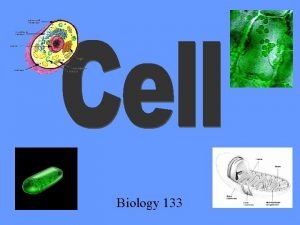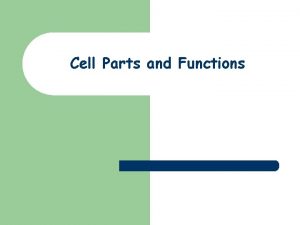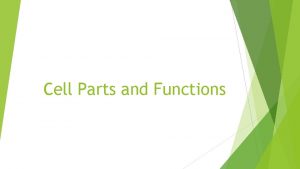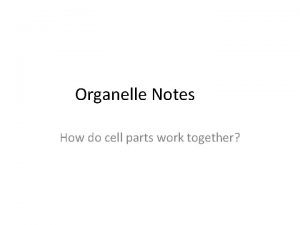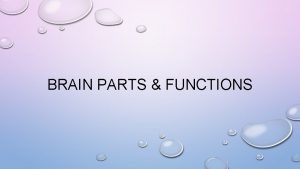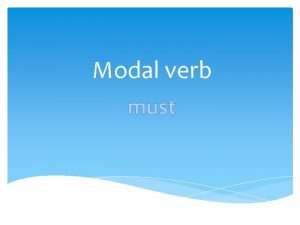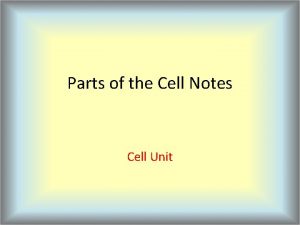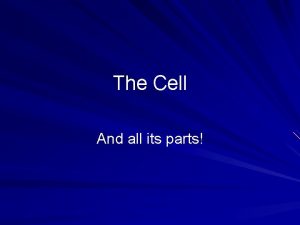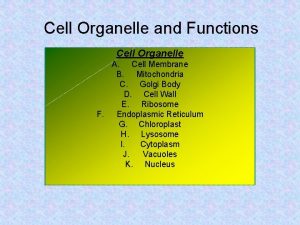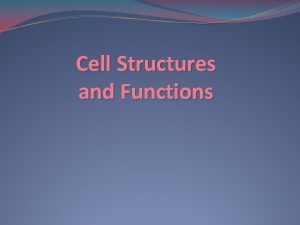Cell Parts and Functions All must work together





























- Slides: 29

Cell Parts and Functions All must work together!

Nucleus • Contains most of the genes in a eukaryotic cell • Directs protein synthesis by synthesizing messenger RNA (m. RNA).

Chromatin and Chromosomes • Within the nucleus, the DNA and associated proteins are organized into fibrous material, chromatin. – diffuse mass • When the cell prepares to divide, the chromatin fibers coil up to be seen as separate structures, chromosomes

Nucleolus • Region in the nucleus • Ribosomal RNA (r. RNA) is synthesized and assembled with proteins from the cytoplasm to form ribosomal subunits. – The subunits go to the cytoplasm where they combine to form ribosomes.

Ribosome • composed of two subunits that combine to carry out protein synthesis – Some ribosomes, free ribosomes, are suspended in the cytosol and synthesize proteins that function within the cytosol. – Other ribosomes, bound ribosomes, are attached to the outside of the endoplasmic reticulum.

Smooth ER • Lacks bound ribosomes • rich in enzymes, plays a role in a variety of metabolic processes: synthesize lipids, including oils, phospholipids, and steroids. • catalyzes a key step in the mobilization of glucose from stored glycogen in the liver. • smooth ER of the liver help detoxify drugs and poisons (including alcohol and barbiturates) – Frequent exposure leads to the proliferation of smooth ER, increasing tolerance to the target and other drugs.


Rough ER • Looks rough because ribosomes (bound ribosomes) are attached to the outside, including the outside of the nuclear envelope. • Secretes proteins made by the attached ribosomes • As a protein is made by the ribosome, it goes into the cisternal space where the new protein folds into its native conformation • Rough ER is also a membrane factory.

Golgi Apparatus • Many transport vesicles from the ER travel to the Golgi apparatus for modification of their contents. • Center of manufacturing, warehousing, sorting, and shipping. • Tags, sorts, and packages materials into transport vesicles.


Lysosome • A membranebounded sac of hydrolytic enzymes that digest macromolecules. • enzymes hydrolyze proteins, fats, polysaccharides, and nucleic acids. • Performs autophagy: recycles and renews part of the cell

Food Vacuole • Formed by cellular eating: storage for “food” • Food vacuoles, from phagocytosis, fuse with lysosomes, for digestion

Central Vacuole • Central vacuoles are found in many mature plant cells. • Functions of include stockpiling proteins or inorganic ions, depositing metabolic byproducts, storing pigments, and storing defensive compounds against herbivores.

Mitochondria • Sites of cellular respiration, generating ATP from the catabolism of sugars, fats, and other fuels in the presence of oxygen – The number of mitochondria is correlated with aerobic metabolic activity.

Chloroplasts • Found in plants and eukaryotic algae, are they produce sugar via photosynthesis. – They convert solar energy to chemical energy and synthesize new organic compounds from CO 2 and H 2 O – Chloroplasts gain their color from high levels of the green pigment chlorophyll.

Peroxisome • Contain enzymes that transfer hydrogen from various substrates to oxygen (intermediate product of this process is hydrogen peroxide) • Break fatty acids down to smaller molecules that are transported to mitochondria for fuel. • Detoxify alcohol and other harmful compounds. • Specialized peroxisomes, glyoxysomes, convert the fatty acids in seeds to sugars, an easier energy and carbon source to transport.

Cytoskeleton • A network of fibers extending throughout the cytoplasm. • Provides mechanical support and maintains shape of the cell. • Provides anchorage for many organelles and cytosolic enzymes. • Helps with cell motility.

Microtubules • Shape and support for the cell. • They move chromosomes during cell division. • Another function is as tracks that guide motor proteins carrying organelles to their destination.

Cilia and Flagella • Both can move unicellular and small multicellular organisms by propelling water past the organism. • Move fluid over a surface. • Ex. cilia sweep mucus carrying trapped debris from the lungs. • Cilia usually occur in large numbers on the cell surface, usually just one or a few flagella per cell – Cilia: move more like oars – Flagella: undulatory movement

Microfilaments • The thinnest class of the cytoskeletal fibers • Pulling forces: cell shape, muscle contraction, amoeboid movement, cytoplasmic streaming – Ex. actin

Intermediate Filaments • Intermediate filaments, intermediate in size at 8 - 12 nanometers, are specialized for bearing tension (pulling) • More permanent fixtures of the cytoskeleton than are the other two classes. • They reinforce cell shape and fix position of certain organelles.

Centrosome • microtubules grow out from a centrosome near the nucleus • Organizes microtubules during cell division

Cell Wall • Found in plants, prokaryotes, fungi, and some protists, has multiple functions. • Protects the cell, maintains its shape, and prevents excessive uptake of water. • It also supports the plant against the force of gravity.

Extracellular Matrix • Lacking cell walls, animals cells do have an elaborate extracellular matrix (ECM). • The interconnections permit the interaction of changes inside and outside the cell. • Can regulate cell behavior. – Embryonic cells migrate along specific pathways by using the fibers of the ECM – May coordinate all the cells within a tissue

Plasmodesmata • Plant cells are perforated with plasmodesmata, channels allowing cysotol to pass between cells.

Tight Junctions • Animal cells have 3 main types of intercellular links: tight junctions, desmosomes, and gap junctions. • In tight junctions, membranes of adjacent cells are fused, forming continuous belts around cells. – This prevents leakage of extracellular fluid.

Desmosomes • Desmosomes (or anchoring junctions) fasten cells together into strong sheets, much like rivets. – Intermediate filaments of keratin reinforce desmosomes.

Gap Junctions • Gap junctions (or communicating junctions) provide cytoplasmic channels between adjacent cells. – Special membrane proteins surround these pores. – Salt ions, sugar, amino acids, and other small molecules can pass. – In embryos, gap junctions facilitate chemical communication during development.

Microvilli • Bundles of microfilaments • Projections that increase the surface area of the cell – Ex. Intestinal lining
 I work all night i work all day
I work all night i work all day We must indeed all hang together
We must indeed all hang together Plant cell vs animal cell
Plant cell vs animal cell Parts of microscope and their functions
Parts of microscope and their functions What fires together wires together
What fires together wires together Name all the lines name all the segments name all the rays
Name all the lines name all the segments name all the rays Surface quality that can be seen and felt
Surface quality that can be seen and felt He must become greater; i must become less
He must become greater; i must become less Koinonia fellowship
Koinonia fellowship Sun and moon together
Sun and moon together Circulatory system and respiratory system work together
Circulatory system and respiratory system work together Dust bowl 1930s
Dust bowl 1930s How does the sun moon and earth work together
How does the sun moon and earth work together Unit 3 house and home
Unit 3 house and home You must put all chemicals and drugs in locked cupboards
You must put all chemicals and drugs in locked cupboards Dodo bird effect definition
Dodo bird effect definition Advantages of diaphragm cell
Advantages of diaphragm cell Prokaryotic cell and eukaryotic cell similarities
Prokaryotic cell and eukaryotic cell similarities Plant and animal cell venn diagram
Plant and animal cell venn diagram Plant cell structure
Plant cell structure Primary voltaic cell
Primary voltaic cell Differences between plant animal and bacterial cells
Differences between plant animal and bacterial cells Section 10-2 cell division
Section 10-2 cell division Prokaryotic cell and eukaryotic cell
Prokaryotic cell and eukaryotic cell Chapter 4 cell theory and cell study
Chapter 4 cell theory and cell study Idealized animal cell and plant cell
Idealized animal cell and plant cell Walker cell and hadley cell
Walker cell and hadley cell Cell cycle and cell division
Cell cycle and cell division Venn diagram animal and plant cell
Venn diagram animal and plant cell Phases of cell cycle
Phases of cell cycle



